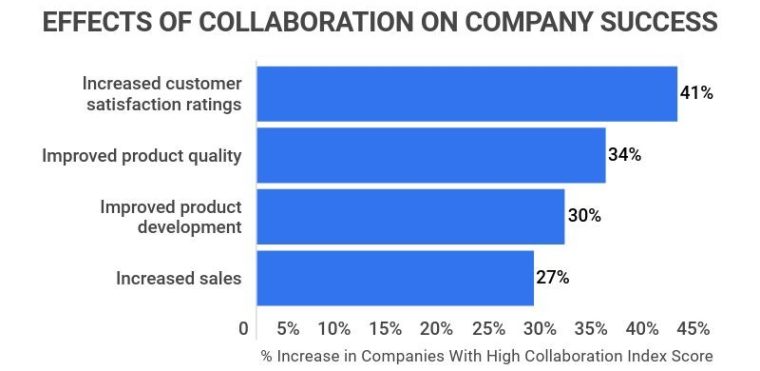At Business2Community, we know that many managers and business people don’t know how to run an effective business meeting – and most likely, their businesses are suffering because of it.
Business meetings are the cornerstone of effective communication and collaboration within organizations. From one-on-one discussions to problem-solving and decision-making sessions, their importance cannot be understated.
In this business-meeting guide, we will take you through the process of planning and conducting the most effective business meetings that you can.
Lets get started.
How to Run a Business Meeting In 7 Steps
It’s not just the chief executive or chief strategist at the company that needs to know how to hold meetings correctly. Everyone on the team, especially anyone in management needs to know how to participate and conduct a meeting. From careful planning to keeping employees engaged, here is how you can plan and run an effective meeting.
1. Plan the Agenda
Work out what type of meeting you want it to be. Do you need your team to update everyone on their projects, progress, and ideas? Plan it like a status update meeting, jotting down how you want to order the agenda and what projects or teams you want to discuss. Make sure that you only include employees who can bring value to the meeting or gain something from it so that you don’t waste anyone’s time.
Once you have a general outline of the meeting, try to think of any information or resources that you or the team may want to reference or investigate. Once you have all the materials ready, distribute them to all meeting participants along with the meeting invite (if possible) before it starts so that they can have time to go over anything they are unfamiliar with.
2. Only Invite the Right (and necessary) Employees
Only invite employees relevant to the task at hand so that other workers aren’t wasting time. Don’t go too far with this, however, as even tangentially related employees can still bring valuable insights to the table.
A 2020 study performed by Penny Zenker found that even organizations with leaders who feel that they are efficient still waste a surprising amount of time if you ask the employees. She found that these organizations were wasting 38 days per year because of meeting inefficiencies – now, that’s food for thought.
3. Optimize Meeting Time
At the beginning of the meeting, quickly go over your agenda with the whole group, detailing how the meeting will be broken down so that everyone is on the same page.
With a specific agenda, this makes it much easier to plan your time better, increasing efficiency and ensuring that you cover everything you need to.
Read more: 14 Calendar Hacks to Help You Optimize and Save Time
4. Record the Meeting
A key aspect of efficient meetings, is to record a meeting using notes or a recorder, ensuring employees and managers can always come back to the points discussed avoiding misunderstandings and missed deadlines.
Online meeting apps make this extremely easy. We’ve previously gone through the most popular online meeting apps, and in this head to head review we go through Google Meet vs Zoom.
5. Stick to the Agenda
Try to keep everyone on-topic and moving through the agenda items at a reasonable pace. Don’t be shy about cutting workers off if you have to but, of course, remain respectful and kind. If you find that the meeting is going off-topic but that the discussion could still be valuable, write it down and schedule a new meeting to discuss it.
6. Finish With an Action Plan
In the last few minutes of your meeting, make actionable plans for each problem or task discussed during the meeting. This helps you make use of everything discussed during the meeting. Many managers like to ask everyone spearheading a certain goal or task to break down what they are doing to encourage accountability and action. You can read more about how to turn your action plan into business results here.
7. Follow Up
Keep track of the biggest takeaways for employees and send a message, whether it’s an informal reminder or a memo, to remind them of what was discussed and what needs to be done going forward. How you follow up matters, and you can read more about following-up on meetings here.
Still not sure how to run an effective meeting? Then watch Adriana Girdler’s video on the topic below.
Importance of Running a Great Business Meeting
Now that we’ve covered how to conduct an effective meetings, its time to deep-dive into the importance of running great business meetings.

Study after study, including the Zippia research above, has found that strong communication and collaboration in the workplace is vital for running an effective business.
Business meetings are often the best way to ensure that communication lines are open and everyone gets their say. Employees can bring up their tasks and goals in the group discussion and can ask the other attendees for help or advice. This helps make the team more cohesive as well.
Furthermore, good business meetings are vital for strong decision-making. The combined experience and expertise of all of the meeting participants is often worth much more than a single manager or executive.
The Importance of Engagement and Face-to-Face Interaction
Once you start the meeting, make sure that everyone in attendance is engaged throughout. This is often relatively easy in in-person meetings but can become a big problem in remote situations. The less your workers are engaged the less value they are bringing to the table.
The surging popularity of online meetings is uncanny; however, face-to-face interaction continues to be better for running successful business meetings.
“Whenever possible, aim to bring teams together for in-person meetings or events. This not only boosts engagement but also strengthens collaboration and relationship-building among team members,” Maddock suggested.
If you don’t have this option and are struggling to keep workers engaged during meetings, there are a few tricks that you can try out including:
- Always celebrate a win of some kind
- Try to sound excited about the topic and avoid the monotone
- Set up a Q&A for everyone in the meeting to participate in
- Ask everyone for their input on relevant subjects directly. Don’t wait for them to weigh in
- Ask everyone to set goals and discuss them in the meeting\
- Screen sharing in online meetings
Generally, going off-topic is not advisable because it seems like a waste of time but if the team has to take a minute or two to listen to a fun story or catch up with each other to stay engaged, it could be worth it. Try to keep these asides to the very beginning of the meeting so you aren’t thrown off of your agenda and the team doesn’t get too distracted.
7 Types of Business Meetings
When a large percentage of today’s work culture depends on large corporations, business meetings make up a big part of many people’s everyday lives. Such gatherings come in a number of forms, tailored to specific objectives and requirements. From one-on-one meetings aimed at bettering individual performance to brainstorming sessions that ignite creativity and collective problem solving let us delve deeper into the types of business meetings.
1. One-on-one Meetings
One-on-one business meetings (also referred to as 1:1 meetings) are private discussions between two participants, oftentimes a manager and an employee. Oftentimes, such meetings foster personal development, performance evaluation, problem-solving, and improved communication. They also aim to strengthen professional relationships and promote individual growth.
One-on-one meetings allow for the often all-too-rare opportunity for managers to hear out their direct reports, listening to their ideas, complaints, pain points, goals, and more. Likewise, employees can gain more specific direction from management so that they can do their jobs better.
2. Brainstorming Meetings
Essential in more creative industries, brainstorming meetings are collaborative sessions where a group of individuals comes together to generate creative ideas, solutions, or strategies for a specific problem, project, or goal. Such meetings stimulate open discussion and the exploration of diverse viewpoints to encourage innovation and creativity.
3. Problem-solving Meetings
Problem-solving meetings bring teams together to help them address specific challenges or obstacles faced by an organization. Such meetings often involve participants systematically analyzing a problem faced by an organization, identifying its causes, and working collaboratively to develop effective solutions or action plans.
4. Informational Meetings
Informational meetings oftentimes happen when an organization has to share some important updates or announcements with its employees. Such meetings are primarily a one-way communication, with the presenter conveying information to the audience.
5. Status update Meetings
Status update meetings involve team members reporting to their superiors their progress on certain projects, tasks, pain points, or milestones. Such meetings can also address any issues an employee may have run into as well as help with major decision-making.
6. Team-building Meetings
Team-building meetings are designed to strengthen the relationships between employees and enhance collaboration among team members. They often involve activities, discussions, and exercises that foster trust, communication, and a sense of unity within the team. Sometimes these are held at the level of a single team while others include the entire company.
7. Decision-making Meetings
Decision-making meetings involve stakeholders gathering together to evaluate options, discuss alternatives, and make important choices. Such meetings aim to get the points of view of various team members, reach a consensus, set directions, and determine the best course of action for the organization or a specific project.
What Is Business Meeting Etiquette?
Knowing the general structure of a good meeting isn’t enough. You also need to know how to best carry out each step with strong business meeting etiquette to improve professionalism as well as efficiency and productivity.
One of the most important aspects of business meeting etiquette is that both employees and executives understand the purpose and value of each meeting.
Natasha Maddock, the co-founder of Events Made Simple UK added:
“Business meeting etiquette is important because it sets the tone for professionalism, efficiency, and respect within an organization. When meetings are conducted with purpose and consideration, it enhances productivity, fosters effective communication, and ultimately contributes to the overall success of the business.”
The Bottom Line
Running an effective business meeting plays a pivotal role in fostering communication, innovation, and collaboration within nearly all companies. By following the general outline of an effective meeting as well as the aforementioned tips, companies should be able to reach their goals in no time.
